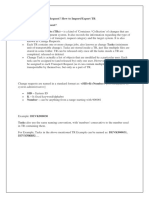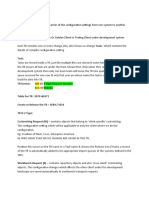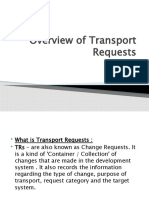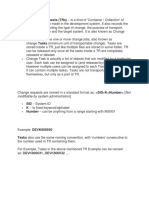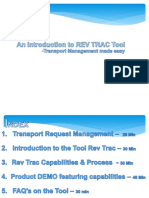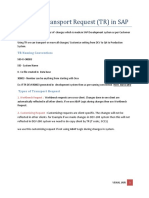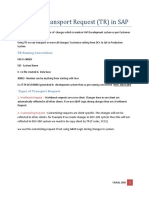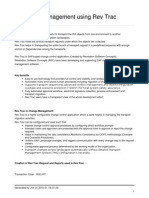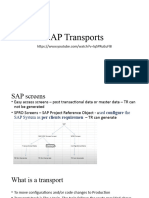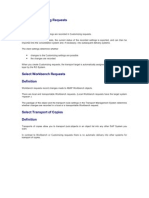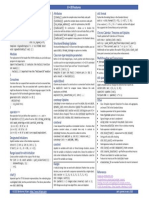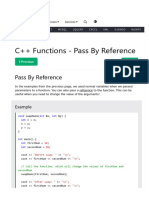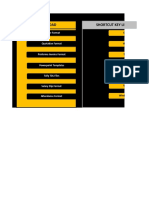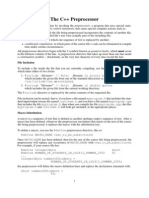Milan Victor – SAP
MILLU138@GMAIL.COM
ABAP/Webdynpro/CDS/ODATA/SAP UI5/FIORI
Transport Requests in SAP ABAP
Purpose of this document:
This document is intended to provide an overview of Transport Requests (TR) within SAP ABAP
What is a Transport Request?
A Transport Request (TR) functions as a comprehensive container for changes made within the
development system, capturing essential details such as the nature of the change, transport
purpose, request category, and target system. It is also referred to as Change Requests. Within
each TR, individual change jobs, or change tasks, serve as the minimal transportable unit of
change, analogous to files stored in folders.
The release of a TR is contingent upon the completion, release, or deletion of all tasks contained
within it. A Change Task is essentially a compilation of objects modified by a specific user, with
each task exclusively assignable to and releasable by a single user. While multiple users can be
assigned to a Transport Request (as it may encompass various tasks), tasks are not transportable
independently but only as integral components of a TR.
TR Example:
DEVK946830
Here,
DEV – System ID
K - Is fixed keyword/alphabet
Number - Can be anything from a range starting with 900001
Tcode – SE01
Types of TR in SAP:
1) Customizing Request
2) Workbench Request
3) Transport of Copies
4) Relocations
https://www.linkedin.com/in/milan-victor-xavier-1713b3192
� Milan Victor – SAP
MILLU138@GMAIL.COM
ABAP/Webdynpro/CDS/ODATA/SAP UI5/FIORI
Customizing Request:
Encompassing items pertinent to 'client-specific' customization, these requests are
automatically logged based on client configurations when users execute customization settings, with the
target system automatically assigned according to the specified transport layer, if defined.
Workbench Request:
In SAP ABAP, a workbench request, also known as a Transport Request, is like a box that holds
changes made in the ABAP Workbench, which is a tool for creating and modifying things in SAP. It makes
it easy to move these changes from one system to another, like from a test system to a live system. The
request contains different types of things, such as items and settings. Once all the changes are done and
checked, the request can be sent to other SAP systems.
Transport of Copies (TOC):
This type of request is used when you want to transport copies of objects from one system to
another. It allows for the duplication of specific configurations or developments without affecting the
original objects.
Relocation TR:
There are three types of relocations:
1) Relocations without package change
2) Relocations with package change
3) Relocations of complete packages
1) Relocations without package change:
Transports involving the relocation of objects, without altering their package, enable the shifting
of the original location from the object list to the target system. Post-transport, the objects persist,
allowing modifications in repairs. If the objects were transportable before, they retain this attribute as
they continue to be associated with the same packages and transport layers.
2) Select relocation of objects with package change:
Relocations of objects with a package change are transports with which
• you change the original location of the objects entered and
• reassign the objects to an appropriate new package.
3) Selection Move Complete Package:
Relocations of complete packages are transports with which you simultaneously
• move the original location of all objects in a package to the target system and
• simultaneously assign the package to another transport layer.
https://www.linkedin.com/in/milan-victor-xavier-1713b3192
� Milan Victor – SAP
MILLU138@GMAIL.COM
ABAP/Webdynpro/CDS/ODATA/SAP UI5/FIORI
How to Create the TR:
There are two ways to create the TR in SAP,
• Automatic
• Manual
Automatic:
When making changes to customizing objects in SAP, the system prompts for a Transport
Request (TR) upon saving, and we can then create the TR. This process is referred to as the automatic
method.
When clicking the SAVE button this popup will come, there we have to click the create button as marked
in the screenshot.
Here we have to give the Description and click the save button.
https://www.linkedin.com/in/milan-victor-xavier-1713b3192
� Milan Victor – SAP
MILLU138@GMAIL.COM
ABAP/Webdynpro/CDS/ODATA/SAP UI5/FIORI
Manual:
Open Tcode – SE01 and click create button, please refer the below screenshot:
Another Popup will come and there we need to select the TR type and click OK button,
https://www.linkedin.com/in/milan-victor-xavier-1713b3192
� Milan Victor – SAP
MILLU138@GMAIL.COM
ABAP/Webdynpro/CDS/ODATA/SAP UI5/FIORI
Next another screen will be opened, there we have to give the description and click the save button.
Then new TR will be created.
Note: Under Task users, we can mention another user also. As we mentioned there, mentioned users
also can access your TR.
https://www.linkedin.com/in/milan-victor-xavier-1713b3192
� Milan Victor – SAP
MILLU138@GMAIL.COM
ABAP/Webdynpro/CDS/ODATA/SAP UI5/FIORI
How to see the open TR’s:
SE01→Select the TR Type→Request status as modifiable→ click Display
How to Release TR and Import into another system:
Release the TR from DVP,
Note: While Release the TR we need to release the Subtasks first.
https://www.linkedin.com/in/milan-victor-xavier-1713b3192
� Milan Victor – SAP
MILLU138@GMAIL.COM
ABAP/Webdynpro/CDS/ODATA/SAP UI5/FIORI
Then we need to release the Main TR,
Import the TR into Quality System,
Tcode – STMS_IMPORT
There we need to press the refresh button,
Then place the cursor on the TR and click Request in the Menu Bar,
https://www.linkedin.com/in/milan-victor-xavier-1713b3192
� Milan Victor – SAP
MILLU138@GMAIL.COM
ABAP/Webdynpro/CDS/ODATA/SAP UI5/FIORI
Give the Target Client number and click OK,
https://www.linkedin.com/in/milan-victor-xavier-1713b3192
� Milan Victor – SAP
MILLU138@GMAIL.COM
ABAP/Webdynpro/CDS/ODATA/SAP UI5/FIORI
Next press Yes in the new popup,
After the import again we need to press refresh button then only status will be changed to green.
Conclusion:
Handling SAP ABAP Transport Requests (TRs) is important for organized development deployment. TRs
capture changes in the ABAP Workbench, ensuring consistency. Different request types, like Workbench
and Customizing Requests, help move changes across environments. Creating and releasing TRs follows
a structured process, ensuring thorough testing before production. Whether using the automatic
method or specialized requests like Transport of Copies, using the transport system effectively is crucial
for developers. This streamlines workflows protects SAP landscapes and contributes to overall efficiency
and success
https://www.linkedin.com/in/milan-victor-xavier-1713b3192

